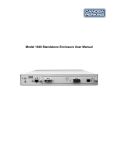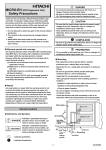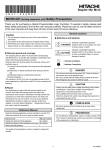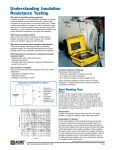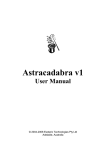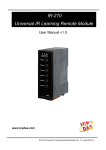Download PCI8282 User`s Manual
Transcript
DASP-52180 12-bit 8 Isolated Analog Input w/ Free-Running Card User’s Manual Disclaimers The information in this manual has been carefully checked and is believed to be accurate. Axiomtek Co., Ltd. assumes no responsibility for any infringements of patents or other rights of third parties which may result from its use. Axiomtek assumes no responsibility for any inaccuracies that may be contained in this document. Axiomtek makes no commitment to update or to keep current the information contained in this manual. Axiomtek reserves the right to make improvements to this document and/or product at any time and without notice. No part of this document may be reproduced, stored in a retrieval system, or transmitted, in any form or by any means, electronic, mechanical, photocopying, recording, or otherwise, without the prior written permission of Axiomtek Co., Ltd. ©Copyright 2004 by Axiomtek Co., Ltd. All rights reserved. September 2004, Version A1.0 Printed in Taiwan ii ESD Precautions Integrated circuits on computer boards are sensitive to static electricity. To avoid damaging chips from electrostatic discharge, observe the following precautions: Do not remove boards or integrated circuits from their anti-static packaging until you are ready to install them. Before handling a board or integrated circuit, touch an unpainted portion of the system unit chassis for a few seconds. This helps to discharge any static electricity on your body. Wear a wrist-grounding strap, available from most electronic component stores, when handling boards and components. Trademarks Acknowledgments AXIOMTEK is a trademark of Axiomtek Co., Ltd. IBM is a registered trademark of International Business Machines Corporation. MS-DOS, and Windows 95/98/NT/2000 are trademarks of Microsoft Corporation. Phoenix-Award is a trademark of Phoenix-Award Software, Inc. IBM, PC/AT, PS/2, VGA are trademarks of International Business Machines Corporation. Intel and Celeron, Pentium III are trademarks of Intel Corporation. Other brand names and trademarks are the properties and registered brands of their respective owners. iii Table of Contents Chapter 1 Introduction.....................................................1 1.1 1.2 1.3 Features ...................................................................2 Specifications..........................................................3 Accessories .............................................................4 Chapter 2 2.1 2.2 Hardware Installation ...................................5 Board Layout ...........................................................5 Signal Connections.................................................6 2.2.1 Signal Connection Descriptions ............................ 6 2.2.2 A/D Counter Connector CON1 ............................. 7 2.3 Jumper Setting ........................................................9 2.3.1 A/D Input Type Jumper Setting (JP1-JP8) ............. 9 2.3.2 A/D Input Range Jumper Setting (JP9-13).......... 10 2.4 2.5 A/D Circuits and Wiring ........................................11 Quick Setup and Test ...........................................12 Chapter 3 Analog Input Range, ADC Code and AD Value ....................................................................................17 Chapter 4 4.1 4.2 Registry Structure and Format...................19 Overview ................................................................19 I/O Register Map....................................................20 4.2.1 Read A/D Channel 0-7 (Base Address + Offset 0x00-07) ............................................................................ 20 4.2.2 Read Axiomtek Product ID (Base Address + 0x0F)20 Appendix A Dimension of DASP-52180 and Accessories ..........................................................................21 Appendix B The AD Calibration of DASP-52180.....23 iv DASP-52180 Card User’s Manual C h a p t e r 1 Introduction The DASP-52180 is a PCI-bus, 8 12-bit isolated analog input card. It provides many powerful features such as free-running mechanism, on-board watchdog timer, and isolation protection of 2500VDC. The card is suitable for laboratories, production line test automation, and measurement control. Advanced S/W Mechanism: Free-Running Free-running is a brand new data-retrieving mechanism to mainly save software SW RD 30% ~ 50% of the time and effort in developing application programs. It helps software RD by using several rows of simple programs to read data, instead of countless numbers in the past. On-Board Watchdog Timer Users can set up time intervals for the timer. While the application programs within the time interval have not connected with DASP/DASA products, the DASP/DASA will be sending out a preset safety value to a devices linked to the DASP/DASA. This helps maintain a stable system. Introduction 1 DASP-52180 Card User’s Manual 1.1 Features 12-bit 8 analog differential inputs. Analog input type: voltage and current Free running A/D sampling (auto-run and auto-update) On-board watchdog timer supported A/D Software programmable zero calibration Windows® 98/NT/2000/XP and Labview 6.0/7.0 driver supported Complete sample program- VB, VC, BCB, Delphi 2 Introduction DASP-52180 Card User’s Manual 1.2 Specifications Analog Input (A/D) Channels: 8 Resolution: 12-bit Input type: differential Input Max. sampling rate: 8K S/s(total channel) Cycle time: 1ms (free-running) Optical isolated: 2500VDC Input impedance: 10M Maximum input over voltage: +/- 10V Accuracy of FSR: +/- 1 LSB Input range: Voltage 10V, 5V, 0-10V, 0-5V, Current 0-20mA Zero calibration: EEPROM on board General Environment I/O connector: 37-pin D-sub female Power consumption: +5V @ 900mA (max.) Operating temperature: 0 ~ 60°C Storage temperature: -20 ~ +70°C Humility: 0 ~ 90% non-condensing Dimensions: 185mm x 122 mm Introduction 3 DASP-52180 Card User’s Manual 1.3 Accessories To make the DASP-52180 functionality complete, we carry a versatility of accessories for different user requirements in the following items: Wiring Cable CB-89037-2: 37-pin female D-sub type cable with 2m length CB-89037-5: 37-pin female D-sub type cable with 5m length The shielded D-sub cable with 2m and 5m are designed for the DASP-52180 analog I/O connector, respectively. Terminal Block TB-88037: D-sub 37-pin female terminal block with DIN-rail mounting The terminal block is directly connected to analog I/O connector of the DASP-52180. 4 Introduction DASP-52180 Card User’s Manual C h a p t e r 2 Hardware Installation 2.1 Board Layout Board Layout for DASP-52180 Hardware Installation 5 DASP-52180 Card User’s Manual 2.2 Signal Connections 2.2.1 Signal Connection Descriptions Signal Connections for DASP-52180 Referring to the above figure, the accessories of the DASP-52180 are depicted and described as below. CON1 The I/O connector CON1 on the DASP-52180 is a 37-pin D-sub connector for differential type analog input signals. CON1 enables you to connect to accessory TB-88037 with the shielded cable CB-89037-2 or CB-89037-5. 6 Hardware Installation DASP-52180 Card User’s Manual 2.2.2 A/D Counter Connector CON1 CON1: A/D Connector Pin Assignment CON1 CB-89037 TB-88037 AIO Signal Connections for DASP-52180 Hardware Installation 7 DASP-52180 Card User’s Manual D-Sub 37-pin Connector for Single-Ended Signal Pin Description Pin Description 19 37 18 36 17 35 16 34 15 33 14 32 13 31 12 30 11 FGND 29 FGND 10 FGND 28 AGND 9 AGND 27 Analog input 7- 8 Analog input 7+ 26 Analog input 6- 7 Analog input 6+ 25 Analog input 5- 6 Analog input 5+ 24 Analog input 4- 5 Analog input 4+ 23 Analog input 3- 4 Analog input 3+ 22 Analog input 2- 3 Analog input 2+ 21 Analog input 1- 2 Analog input 1+ 20 Analog input 0- 1 Analog input 0+ AGND: analog ground FGND: Connect to shielded line if necessary 8 Hardware Installation DASP-52180 Card User’s Manual 2.3 Jumper Setting 2.3.1 A/D Input Type Jumper Setting (JP1-JP8) Analog Input Type (A/D Channel 0 – A/D Channel 7) 1 1 2 2 Jumper Open Pin Short Pin JP1-JP8 Voltage Input (Default) Current Input Hardware Installation 9 DASP-52180 Card User’s Manual 2.3.2 A/D Input Range Jumper Setting (JP9-13) Default Setting: ±10V Range JP9 JP10 JP11 JP12 JP13 0~20mA 0~5 V 0~10V ±5V ±10V 10 Hardware Installation DASP-52180 Card User’s Manual 2.4 A/D Circuits and Wiring The analog input and wiring block diagram of DASP-52180 is depicted as follows. Isolated Input Circuit AI0+ AD 0 (+) AI0- AD 0 (-) AI7+ AD 7 (+) AI7- AD 7 (-) 250Ω 1MΩ 1MΩ AGND Jumper Setting (Current Input) Voltage Input (+/-10V, +/-5V, 0-10V, 0-5V) Current Input (0-20mA) Analog Input Block Diagram for DASP-52180 Hardware Installation 11 DASP-52180 Card User’s Manual 2.5 Quick Setup and Test To install a new DASP-52180 into an IBM PC compatible computer, at first, power-off the PC and open its chassis, then plug the DASP-52180 into a PCI slot. The DASP-52180 is a plug and play device for MS Windows, and the OS will detect your DASP-52180 after you power on the PC. The detail of driver and software installation is described in software manual of DASP-52180. After the hardware and software installation, user can emulate and test DASP-52180 step by step as follows. To perform a complete test of the DASP-52180, we can route the input signals of the DASP-52180 with a specific signal source for read-back. And then, by following the DASP-52180 test branch of the ToolWorkShop which will fully test I/O channels of the DASP-52180 as descried in the following paragraphs. Launch the ‘PCI Configuration Utility’ of DASP-52180 to ensure that the resource of DASP-52180 is properly dispatched by the OS. Press the scan button in the toolbar of the ‘PCI Configuration Utility’ to find the installed DASP-52180, and then check the resource list as follows. Scan DASP-52180 with PCI configuration Utility and check the dispatched resource 12 Hardware Installation DASP-52180 Card User’s Manual Exit the ‘PCI Configuration Utility’ and launch the ‘ToolWorkShop’ for DASP-52180. As shown follows. launch ToolWorkShop Select board test Hardware Installation 13 DASP-52180 Card User’s Manual Perform Timer/Counter and DIO test of DASP-52180 as shown in following. 3 Select Test Target: DASP-52180 14 Hardware Installation DASP-52180 Card User’s Manual 4 Check Device Information and Press ‘Setup’ Button to Load DASP-52180 Library. Perform Analog Input Test by Pressing the ‘Run’ Button to Read Back the AI Value of DASP-52180 Before exiting ‘ToolWorkShop’, press ‘Release’ button to release DASP-52180 library. Hardware Installation 15 DASP-52180 Card User’s Manual This page does not contain any information. 16 Hardware Installation DASP-52180 Card User’s Manual C h a p t e r 3 Analog Input Range, ADC Code and AD Value A almost linear mapping exist between the 12-bit ADC code and analog input for the DASP-52180. The following figure depicts the linear mapping of AD code of DASP-52180 and the analog input signal. FS denotes the full span of analog input under the user configured analog input range. The mapping of analog input to ADC code of DASP-52180 at ±FS and 0 input under different analog input ranges are listed in following table. 0xFFF 0xFFF 0x800 0x800 0 -FS 0 0 Bipolar Input +FS 0 +FS/2 +FS Uni-Polar Input Mapping of 12-bit ADC Code and Analog Input for DASP-52180 Analog Input Range, ADC Code and AD Value 17 DASP-52180 Card User’s Manual Input Range ±10V ±5V 0~10V 0~5V 0~20mA Zero -Full Scale +9.99512 ±00.000 -10.000 0.00488V 0xFFF/4095 0x800/2048 0x0/0 1LSB +4.99756 ±00.000 -5.000 0.00244V 0xFFF/4095 0x800/2048 0x0/0 1LSB +9.99756 ±00.000 *** 0.00244V 0xFFF/4095 0x0/0 *** 1LSB +4.99878 ±00.000 *** 0.00122V 0xFFF/4095 0x0/0 *** 1LSB +19.9912 ±00.000 *** 0.00488mA 0xFFF/4095 0x0/0 *** 1LSB +Full Scale Data Resolution Input Range, Data / Code and Resolution of DASP-52180 18 Analog Input Range, ADC Code and AD Value DASP-52180 Card User’s Manual C h a p t e r 4 Register Structure and Format 4.1 Overview The DASP-52180 board occupies 16 consecutive I/O address. The address of each register is defined as the board’s base address plus an offset. The I/O registers and their corresponding functions are listed in the followings. RD WR 0 1 1 0 0 1 1 0 0 1 1 0 0 1 1 0 0 1 1 0 0 1 1 0 0 1 1 0 0 1 1 0 0 1 1 0 A4 A3 A2 A1 Port Name X X X Read A/D Channels 0 ~ 7 0 X X Reserved 1 0 0 0 1 0 0 1 1 0 1 0 1 0 1 1 1 1 0 0 1 1 0 1 1 1 1 0 1 1 1 1 0 Registry Structure and Format Reserved Reserved Reserved Reserved Reserved Reserved Reserved Reserved Reserved Reserved Reserved Reserved Reserved Reserved Read HAL ID Reserved 19 DASP-52180 Card User’s Manual 4.2 I/O Register Map 4.2.1 Read A/D Channel 0-7 (Base Address + Offset 0x00-07) D7 D6 D5 D4 D3 D2 D1 D0 D9 D8 12 bit A/D Data (D0-D7) D15 D14 D13 D12 0 0 0 0 D11 D10 12 bit A/D Data (D8-D11) 4.2.2 Read Axiomtek Product ID (Base Address + 0x0F) D7 D6 D5 D4 D3 D2 D1 D0 Card ID: 00001100 FPGA Version (00000000 ~ 11111111) D15 D14 D13 D12 D11 D10 D9 D8 0 1 0 0 1 0 0 0 0 1 0 1 0 1 1 0 Note: 01001000 (48H): ASCII ‘H’ for HAL 01010110 (56H): ASCII ‘V’ for Version Remarks: Read this port twice to get both HAL product information. 20 Registry Structure and Format DASP-52180 Card User’s Manual Appendix A Dimension of DASP-52180 and Accessories DASP-52180 Dimension of DASP-52180 and Accessories 21 DASP-52180 Card User’s Manual TB-88037 77 52 112 22 Dimension of DASP-52180 and Accessories DASP-52180 Card User’s Manual Appendix B The AD Calibration of DASP-52180 Zero Voltage Calibration Execute the calibration program: CalibrationDASP52180.exe Select (1) Reset EEPROM Press <ESC> to exit calibration program Re-execute the calibration program: CalibrationDASP52180.exe Press <Enter> under Calibration selection, the calibration coefficients update to 1000 Press <Enter> Input “0” voltage from external signal source Recode the input voltage of each channel Press <ESC> to exit calibration program Select (2) Write Zero Coefficient to EEPROM Input the 0V calibration coefficients from CH0 to CH7. The coefficients are decided as following: If the measurement voltage is higher than 0mV, the coefficient equals to 1000 + the integer part of measurement value (unit: mV) If the measurement voltage is less than 0mV, the coefficient equals to 1000 - the integer part of measurement value (unit: mV) Press <ESC> to exit calibration program and repeat step 4 and 5 The coefficient 16~23 should be the previous input value and others were 10000 Input “0” voltage under Analog Input (AD) Test menu Measure the voltage of each channel, the value should be less then +/- 2mV The AD Calibration of DASP-52180 23 DASP-52180 Card User’s Manual +/- 10V Voltage Calibration Execute the calibration program: CalibrationDASP52180.exe Press <Enter> under Calibration selection, The coefficient from 00 to 15 should be 10000 and CH16~23 should be the previous input value Press <Enter>, Input “10” V from external signal source Recode the input voltage of each channel Input “-10” V from external signal source Recode the input voltage of each channel Press <ESC> to exit calibration program and repeat step 1 Select (3) Write Span Coefficient to EEPROM Input the +/- 10V calibration coefficients from AD0 to AD7. The coefficients equal to the integer part of (1000 X measurement value (unit: mV)) Repeat 7 and Press <Enter> under Calibration selection, The coefficient from should be the previous input value Press <Enter>, read AD value under Analog Input (AD) Test menu. The voltage of each channel should be in the range of 10V+/- 2mV Press <Enter>, read AD value under Analog Input (AD) Test menu. The voltage of each channel should be in the range of -10V+/- 2mV 1. Press <ESC> to exit calibration program 24 The AD Calibration of DASP-52180





























